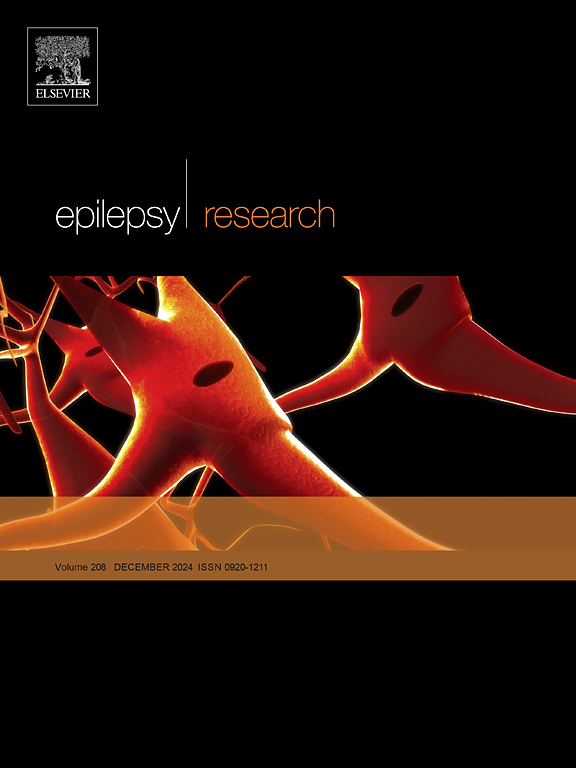Clinical and EEG characteristics of sleep-related hypermotor epilepsy in children
IF 2
4区 医学
Q3 CLINICAL NEUROLOGY
引用次数: 0
Abstract
Background
Sleep-related hypermotor epilepsy (SHE) is a focal epilepsy with nocturnal hypermotor seizures. Although SHE was redefined in 2014, comprehensive pediatric studies are still lacking for this disorder. To address this need, here we describe the clinical and electroencephalography (EEG) characteristics of children with SHE.
Methods
We retrospectively enrolled pediatric patients with SHE diagnosis who were hospitalized at our institution from August 1, 2021, to August 31, 2023.
Results
Among the 47 patients, 31.9 % and 42.6 % manifested as SP2 and SP3, respectively. A total of 57.4 % of the patients showed a focal discharge as diagnosed by interictal EEG, 36.2 % showed multifocal discharges, and 6.4 % did not have discharge. Ictal EEG revealed that 66.0 % of patients presented with frontal lobe onset, 10.6 % with temporal lobe onset, and 23.4 % with unknown onset. Further, 36.2 % of patients had a structural etiology, approximately 80 % of those patients had focal cortical dysplasia. Finally, 23 patients were diagnosed with refractory epilepsy, and 15 of them underwent surgery.
Conclusions
Patients mainly presented as SP3 and SP2. The focal discharges detected by interictal EEG accounted for approximately 57.4 % and the frontal lobe onset detected by ictal EEG accounted for approximately 66 %. Structural etiology (mainly focal cortical dysplasia) accounted for approximately 33 %, and surgery was an effective treatment for these patients.
儿童睡眠相关性运动性癫痫的临床和脑电图特征。
背景:睡眠相关性多运动性癫痫(SHE)是一种伴夜间多运动性发作的局灶性癫痫。尽管SHE在2014年被重新定义,但对这种疾病的全面儿科研究仍然缺乏。为了满足这一需求,我们在这里描述了SHE儿童的临床和脑电图(EEG)特征。方法:回顾性纳入2021年8月1日至2023年8月31日在我院住院的SHE诊断的儿科患者。结果:47例患者中,分别有31.9 %和42.6 %表现为SP2和SP3。间期脑电图诊断为局灶性放电的患者占57.4% %,多局灶性放电的患者占36.2% %,无放电的患者占6.4 %。脑电图显示66.0 %的患者表现为额叶发病,10.6 %表现为颞叶发病,23.4% %表现为发病不详。此外,36.2% %的患者有结构性病因,大约80% %的患者有局灶性皮质发育不良。最终,23例患者被诊断为难治性癫痫,其中15例患者接受了手术治疗。结论:患者主要表现为SP3和SP2。间歇期脑电图检测到的局灶放电约占57.4% %,间歇期脑电图检测到的额叶发作约占66% %。结构病因(主要是局灶性皮质发育不良)约占33% %,手术是这些患者的有效治疗方法。
本文章由计算机程序翻译,如有差异,请以英文原文为准。
求助全文
约1分钟内获得全文
求助全文
来源期刊

Epilepsy Research
医学-临床神经学
CiteScore
0.10
自引率
4.50%
发文量
143
审稿时长
62 days
期刊介绍:
Epilepsy Research provides for publication of high quality articles in both basic and clinical epilepsy research, with a special emphasis on translational research that ultimately relates to epilepsy as a human condition. The journal is intended to provide a forum for reporting the best and most rigorous epilepsy research from all disciplines ranging from biophysics and molecular biology to epidemiological and psychosocial research. As such the journal will publish original papers relevant to epilepsy from any scientific discipline and also studies of a multidisciplinary nature. Clinical and experimental research papers adopting fresh conceptual approaches to the study of epilepsy and its treatment are encouraged. The overriding criteria for publication are novelty, significant clinical or experimental relevance, and interest to a multidisciplinary audience in the broad arena of epilepsy. Review articles focused on any topic of epilepsy research will also be considered, but only if they present an exceptionally clear synthesis of current knowledge and future directions of a research area, based on a critical assessment of the available data or on hypotheses that are likely to stimulate more critical thinking and further advances in an area of epilepsy research.
 求助内容:
求助内容: 应助结果提醒方式:
应助结果提醒方式:


